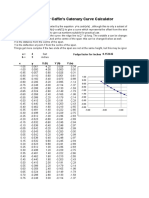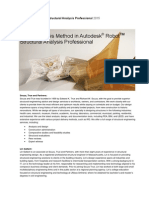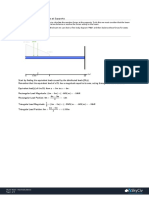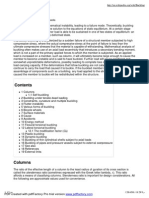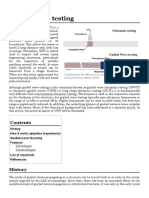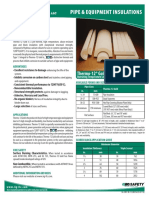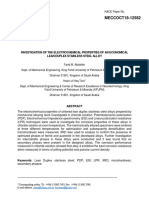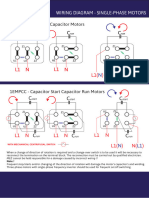Buckling
Buckling
Uploaded by
alphadingCopyright:
Available Formats
Buckling
Buckling
Uploaded by
alphadingOriginal Description:
Copyright
Available Formats
Share this document
Did you find this document useful?
Is this content inappropriate?
Copyright:
Available Formats
Buckling
Buckling
Uploaded by
alphadingCopyright:
Available Formats
Buckling
For other uses, see Buckling (disambiguation).
In science, buckling is a mathematical instability, lead-
ing to a failure mode. Theoretically, buckling is caused
by a bifurcation in the solution to the equations of static
equilibrium. At a certain stage under an increasing load,
further load is able to be sustained in one of two states of
equilibrium: an undeformed state or a laterally-deformed
state.
In practice, buckling is characterized by a sudden fail-
ure of a structural member subjected to high compressive
stress, where the actual compressive stress at the point of
failure is less than the ultimate compressive stresses that
the material is capable of withstanding. Mathematical
analysis of buckling often makes use of an axial load ec-
centricity that introduces a secondary bending moment,
which is not a part of the primary applied forces to which
the member is subjected. As an applied load is increased
on a member, such as column, it will ultimately become
large enough to cause the member to become unstable and
is said to have buckled. Further load will cause signi-
cant and somewhat unpredictable deformations, possibly
leading to complete loss of the members load-carrying
capacity. If the deformations that follow buckling are not
catastrophic the member will continue to carry the load
that caused it to buckle. If the buckled member is part
of a larger assemblage of components such as a build-
ing, any load applied to the structure beyond that which
caused the member to buckle will be redistributed within
the structure.
1 Columns
The ratio of the eective length of a column to the least
radius of gyration of its cross section is called the slen-
derness ratio (sometimes expressed with the Greek let-
ter lambda, ). This ratio aords a means of classify-
ing columns. Slenderness ratio is important for design
considerations. All the following are approximate values
used for convenience.
A short steel column is one whose slenderness ratio
does not exceed 50; an intermediate length steel col-
umn has a slenderness ratio ranging fromabout 50 to
200, and are dominated by the strength limit of the
material, while a long steel column may be assumed
to have a slenderness ratio greater than 200 and its
behavior is dominated by the modulus of elasticity
A column under a concentric axial load exhibiting the character-
istic deformation of buckling
The eccentricity of the axial force results in a bending moment
acting on the beam element.
of the material.
A short concrete column is one having a ratio of un-
supported length to least dimension of the cross sec-
tion equal to or less than 10. If the ratio is greater
than 10, it is considered a long column (sometimes
referred to as a slender column).
Timber columns may be classied as short columns
if the ratio of the length to least dimension of the
cross section is equal to or less than 10. The dividing
line between intermediate and long timber columns
cannot be readily evaluated. One way of dening the
lower limit of long timber columns would be to set
it as the smallest value of the ratio of length to least
cross sectional area that would just exceed a certain
1
2 1 COLUMNS
constant K of the material. Since K depends on the
modulus of elasticity and the allowable compressive
stress parallel to the grain, it can be seen that this
arbitrary limit would vary with the species of the
timber. The value of K is given in most structural
handbooks.
If the load on a column is applied through the center of
gravity (centroid) of its cross section, it is called an axial
load. A load at any other point in the cross section is
known as an eccentric load. Ashort column under the ac-
tion of an axial load will fail by direct compression before
it buckles, but a long column loaded in the same manner
will fail by buckling (bending), the buckling eect being
so large that the eect of the axial load may be neglected.
The intermediate-length column will fail by a combina-
tion of direct compressive stress and bending.
In 1757, mathematician Leonhard Euler derived a for-
mula that gives the maximum axial load that a long, slen-
der, ideal column can carry without buckling. An ideal
column is one that is perfectly straight, homogeneous,
and free from initial stress. The maximum load, some-
times called the critical load, causes the column to be in
a state of unstable equilibrium; that is, the introduction
of the slightest lateral force will cause the column to fail
by buckling. The formula derived by Euler for columns
with no consideration for lateral forces is given below.
However, if lateral forces are taken into consideration the
value of critical load remains approximately the same.
F =
2
EI
(KL)
2
where
F = maximum or critical force (vertical load
on column),
E = modulus of elasticity,
I = area moment of inertia,
L = unsupported length of column,
K = column eective length factor, whose
value depends on the conditions of end support
of the column, as follows.
K
K
K
K
KL is the eective length of the column.
Examination of this formula reveals the following inter-
esting facts with regard to the load-bearing ability of slen-
der columns.
1. Elasticity and not the compressive strength of the
materials of the column determines the critical load.
2. The critical load is directly proportional to the
second moment of area of the cross section.
3. The boundary conditions have a considerable eect
on the critical load of slender columns. The bound-
ary conditions determine the mode of bending and
the distance between inection points on the de-
ected column. The inection points in the deec-
tion shape of the column are the points at which the
curvature of the column change sign and are also the
points at which the internal bending moments are
zero. The closer together the inection points are,
the higher the resulting capacity of the column.
A demonstration model illustrating the dierent Euler buckling
modes. The model shows how the boundary conditions aect the
critical load of a slender column. Notice that each of the columns
are identical, apart from the boundary conditions.
The strength of a column may therefore be increased by
distributing the material so as to increase the moment of
inertia. This can be done without increasing the weight
of the column by distributing the material as far from the
principal axis of the cross section as possible, while keep-
ing the material thick enough to prevent local buckling.
This bears out the well-known fact that a tubular section
is much more ecient than a solid section for column
service.
Another bit of information that may be gleaned from this
equation is the eect of length on critical load. For a
given size column, doubling the unsupported length quar-
ters the allowable load. The restraint oered by the end
connections of a column also aects the critical load. If
the connections are perfectly rigid, the critical load will
be four times that for a similar column where there is no
resistance to rotation (in which case the column is ideal-
ized as having hinges at the ends).
Since the radius of gyration is dened as the square root
of the ratio of the columns moment of inertia about an
axis to cross sectional area, the above formula may be
rearranged as follows. Using the Euler formula for hinged
3
ends, and substituting Ar
2
for I, the following formula
results.
=
F
A
=
2
E
(/r)
2
where F/Ais the allowable stress of the column, and l/r
is the slenderness ratio.
Since structural columns are commonly of intermediate
length, and it is impossible to obtain an ideal column,
the Euler formula on its own has little practical applica-
tion for ordinary design. Issues that cause deviation from
the pure Euler column behaviour include imperfections in
geometry in combination with plasticity/non-linear stress
strain behaviour of the columns material. Consequently,
a number of empirical column formulae have been de-
veloped to agree with test data, all of which embody the
slenderness ratio. For design, appropriate safety factors
are introduced into these formulae. One such formula is
the Perry Robertson formula which estimates the critical
buckling load based on an initial (small) curvature. The
Rankine Gordon formula (Named for WilliamJohn Mac-
quorn Rankine and Perry Hugesworth Gordon (1899
1966)) is also based on experimental results and suggests
that a column will buckle at a load F given by:
1
F
max
=
1
F
e
+
1
F
c
where F is the Euler maximum load and F is the maxi-
mum compressive load. This formula typically produces
a conservative estimate of F.
1.1 Self-buckling
Afree-standing, vertical column, with density , Youngs
modulus E , and radius r , will buckle under its own
weight if its height exceeds a certain critical height:
[1][2][3]
h
crit
=
(
9B
2
4
EI
gr
2
)
1/3
where g is the acceleration due to gravity, I is the second
moment of area of the beam cross section, and B is the
rst zero of the Bessel function of the rst kind of order
1/3, which is equal to 1.86635086...
2 Buckling under tensile dead
loading
Usually buckling and instability are associated to com-
pression, but recently Zaccaria, Bigoni, Noselli and Mis-
seroni (2011)
[4]
have shown that buckling and instability
Fig. 2: Elastic beam system showing buckling under tensile dead
loading.
can also occur in elastic structures subject to dead tensile
load. An example of a single-degree-of-freedom struc-
ture is shown in Fig. 1, where the critical load is also in-
dicated. Another example involving exure of a structure
made up of beam elements governed by the equation of
the Eulers elastica is shown in Fig.2. In both cases, there
are no elements subject to compression. The instability
and buckling in tension are related to the presence of the
slider, the junction between the two rods, allowing only
relative sliding between the connected pieces. Watch a
movie for more details.
3 Constraints, curvature and mul-
tiple buckling
Fig. 3: A one-degree-of-freedom structure exhibiting a tensile
(compressive) buckling load as related to the fact that the right
end has to move along the circular prole labeled 'Ct' (labelled
'Cc').
Buckling of an elastic structure strongly depends on the
curvature of the constraints against which the ends of the
structure are prescribed to move (see Bigoni, Misseroni,
Noselli and Zaccaria, 2012
[5]
). In fact, even a single-
degree-of-freedom system (see Fig.3) may exhibit a ten-
sile (or a compressive) buckling load as related to the fact
that one end has to move along the circular prole labeled
'Ct' (labelled 'Cc').
The two circular proles can be arranged in a 'S'-shaped
prole, as shown in Fig.4; in that case a discontinuity of
the constraints curvature is introduced, leading to multi-
ple bifurcations. Note that the single-degree-of-freedom
structure shown in Fig.4 has two buckling loads (one ten-
sile and one compressive). Watch a movie for more de-
4 5 VARIOUS FORMS OF BUCKLING
Fig. 4: A one-degree-of-freedom structure with a 'S'-shaped bi-
circular prole exhibiting multiple bifurcations (both tensile and
compressive).
tails.
4 Flutter instability
Structures subject to a follower (nonconservative) load
may suer instabilities which are not of the buckling type
and therefore are not detectable with a static approach.
[6]
For instance, the so-called 'Ziegler column' is shown in
Fig.5.
Fig. 5: Asketch of the 'Ziegler column', a two-degree-of-freedom
systemsubject to a follower load (the force P remains always par-
allel to the rod BC), exhibiting utter and divergence instability.
The two rods, of linear mass density , are rigid and connected
through two rotational springs of stiness k1 and k2.
This two-degree-of-freedom system does not display a
quasi-static buckling, but becomes dynamically unstable.
To see this, we note that the equations of motion are
1
3
l
2
1
(l
1
+ 3l
2
)
1
+
1
2
l
1
l
2
2
cos(
1
2
)
2
+
1
2
l
1
l
2
2
sin(
1
2
)
2
2
+ (k
1
+k
2
)
1
k
2
2
+
+(
1
+
2
)
1
2
2
l
1
P sin(
1
2
) = 0,
1
2
l
1
l
2
2
cos(
1
2
)
1
+
1
3
l
3
2
2
1
2
l
1
l
2
2
sin(
1
2
)
2
1
k
2
(
1
2
)
2
(
1
2
) = 0,
and their linearized version is
1
3
l
2
1
(l
1
+ 3l
2
)
1
+
1
2
l
1
l
2
2
2
+ (k
1
+k
2
)
1
k
2
2
l
1
P(
1
2
) = 0,
1
2
l
1
l
2
2
1
+
1
3
l
3
2
2
k
2
(
1
2
) = 0.
Assuming a time-harmonic solution in the form
j
= A
j
e
it
, j = 1, 2,
we nd the critical loads for utter ( P
f
) and divergence
( P
d
),
P
f,d
=
k
2
l
1
k + (1 +)
3
k(3 + 4)
1 + 3/2
where = l
1
/l
2
and k = k
1
/k
2
.
Fig. 6: A sequence of deformed shapes at consecutive times in-
tervals of the structure sketched in Fig.5 and exhibiting utter
(upper part) and divergence (lower part) instability.
Flutter instability corresponds to a vibrational motion of
increasing amplitude and is shown in Fig.6 (upper part)
together with the divergence instability (lower part) con-
sisting in an exponential growth.
Recently, Bigoni and Noselli (2011)
[7]
have experimen-
tally shown that utter and divergence instabilities can be
directly related to dry friction, watch the movie for more
details.
5 Various forms of buckling
Buckling is a state which denes a point where an equilib-
rium conguration becomes unstable under a parametric
change of load and can manifest itself in several dierent
phenomena. All can be classied as forms of bifurcation.
There are four basic forms of bifurcation associated with
loss of structural stability or buckling in the case of struc-
tures with a single degree of freedom. These comprise
two types of pitchfork bifurcation, one saddle-node bi-
furcation (often referred to as a limit point) and one
transcritical bifurcation. The pitchfork bifurcations are
the most commonly studied forms and include the buck-
ling of columns and struts, sometimes known as Euler
buckling; the buckling of plates, sometimes known as lo-
cal buckling, which is well known to be relatively safe
5
(both are supercritical phenomena) and the buckling of
shells, which is well-known to be a highly dangerous (sub-
critical phenomenon).
[8]
Using the concept of potential
energy, equilibrium is dened as a stationary point with
respect to the degree(s) of freedom of the structure. We
can then determine whether the equilibrium is stable, if
the stationary point is a local minimum; or unstable, if
it is a maximum, point of inection or saddle point (for
multiple-degree-of-freedom structures only) see ani-
mations below.
In Euler buckling,
[9][10]
the applied load is increased by
a small amount beyond the critical load, the structure de-
forms into a buckled conguration which is adjacent to
the original conguration. For example, the Euler col-
umn pictured will start to bow when loaded slightly above
its critical load, but will not suddenly collapse.
In structures experiencing limit point instability, if the
load is increased innitesimally beyond the critical load,
the structure undergoes a large deformation into a dier-
ent stable conguration which is not adjacent to the orig-
inal conguration. An example of this type of buckling
is a toggle frame (pictured) which 'snaps into its buckled
conguration.
6 Bicycle wheels
A conventional bicycle wheel consists of a thin rim kept
under high compressive stress by the (roughly normal) in-
ward pull of a large number of spokes. It can be consid-
ered as a loaded column that has been bent into a cir-
cle. If spoke tension is increased beyond a safe level,
the wheel spontaneously fails into a characteristic saddle
shape (sometimes called a taco or a extquotedblpringle
extquotedbl) like a three-dimensional Euler column. This
is normally a purely elastic deformation and the rim will
resume its proper plane shape if spoke tension is reduced
slightly.
7 Surface materials
Sun kink in rail tracks
Buckling is also a failure mode in pavement materials,
primarily with concrete, since asphalt is more exible.
Radiant heat from the sun is absorbed in the road sur-
face, causing it to expand, forcing adjacent pieces to push
against each other. If the stress is great enough, the
pavement can lift up and crack without warning. Going
over a buckled section can be very jarring to automobile
drivers, described as running over a speed hump at high-
way speeds.
Similarly, rail tracks also expand when heated, and can
fail by buckling, a phenomenon called sun kink. It is
more common for rails to move laterally, often pulling
the underlain railroad ties (sleepers) along.
8 Energy method
Often it is very dicult to determine the exact buckling
load in complex structures using the Euler formula, due
to the diculty in deciding the constant K. Therefore,
6 12 DYNAMIC BUCKLING
maximum buckling load often is approximated using en-
ergy conservation. This way of calculating the maximum
buckling load is often referred to as the energy method in
structural analysis.
The rst step in this method is to suggest a displacement
function. This function must satisfy the most important
boundary conditions, such as displacement and rotation.
The more accurate the displacement function, the more
accurate the result.
In this method, there are two equations used (for small
deformations) to approximate the inner energy (the po-
tential energy stored in elastic deformation of the struc-
ture) and outer energy (the work done on the system by
external forces).
U
inner
=
E
2
I(x)(w
xx
(x))
2
dx
U
outer
=
P
Crit
2
(w
x
(x))
2
dx
where w(x) is the displacement function and the sub-
scripts x and xx refer to the rst and second derivatives
of the displacement. Energy conservation yields:
U
Inner
= U
Outer
9 Flexural-torsional buckling
Occurs in compression members only and it can be de-
scribed as a combination of bending and twisting of a
member. And it must be considered for design purposes,
since the shape and cross sections are very critical. This
mostly occurs in channels, structural tees, double-angle
shapes, and equal-leg single angles.
10 Lateral-torsional buckling
When a simply supported beam is loaded in exure, the
top side is in compression, and the bottom side is in
tension. When a slender member is subjected to an axial
force, failure takes place due to bending or torsion rather
than direct compression of the material. If the beam is
not supported in the lateral direction (i.e., perpendicular
to the plane of bending), and the exural load increases
to a critical limit, the beam will fail due to lateral buck-
ling of the compression ange. In wide-ange sections,
if the compression ange buckles laterally, the cross sec-
tion will also twist in torsion, resulting in a failure mode
known as lateral-torsional buckling.
10.1 The modication factor (Cb)
where
M
max
M
A
M
B
M
C
11 Plastic buckling
Buckling will generally occur slightly before the calcu-
lated elastic buckling strength of a structure, due to non-
linear behavior of the material. When the compressive
load is near the buckling load, the structure will bow sig-
nicantly and the material of the column will diverge
from a linear stress-strain behavior. The stress-strain
behavior of materials is not strictly linear even below
yield, and the modulus of elasticity decreases as stress in-
creases, and signicantly so as the stresses approach the
yield strength. This lower rigidity reduces the buckling
strength of the structure and causes at a load less than that
predicted by the assumption of lineal elastic behavior.
A more accurate approximation of the buckling load can
be had by the use of the tangent modulus of elasticity, E,
in place of the elastic modulus of elasticity. The tangent
modulus is a line drawn tangent to the stress-strain curve
at a particular value of strain. Plots of the tangent modu-
lus of elasticity for a variety of materials are available in
standard references.
12 Dynamic buckling
If a column is loaded suddenly and then the load re-
leased, the column can sustain a much higher load than
its static (slowly applied) buckling load. This can happen
in a long, unsupported column (rod) used as a drop ham-
mer. The duration of compression at the impact end is the
time required for a stress wave to travel up the rod to the
other (free) end and back down as a relief wave. Maxi-
mumbuckling occurs near the impact end at a wavelength
much shorter than the length of the rod, and at a stress
many times the buckling stress of a statically-loaded col-
umn. The critical condition for buckling amplitude to
remain less than about 25 times the eective rod straight-
ness imperfection at the buckle wavelength is
L = c
2
h
where is the impact stress, Lis the length of the rod, c is
the elastic wave speed, and h is the smaller lateral dimen-
sion of a rectangular rod. Because the buckle wavelength
depends only on and h , this same formula holds for
thin cylindrical shells of thickness h .
[12]
7
13 Buckling of thin cylindrical
shells subject to axial loads
Solutions of Donnells eight order dierential equation
gives the various buckling modes of a thin cylinder under
compression. But this analysis, which is in accordance
with the small deection theory gives much higher val-
ues than shown from experiments. So it is customary to
nd the critical buckling load for various structures which
are cylindrical in shape from pre-existing design curves
where critical buckling load F is plotted against the ra-
tio R/t, where R is the radius and t is the thickness of
the cylinder for various values of L/R, L the length of the
cylinder. If cut-outs are present in the cylinder, critical
buckling loads as well as pre-buckling modes will be af-
fected. Presence or absence of reinforcements of cut-outs
will also aect the buckling load.
14 Buckling of pipes and pressure
vessels subject to external over-
pressure
Pipes and pressure vessels subject to external overpres-
sure, caused for example by steamcooling within the pipe
and condensing into water with subsequent massive pres-
sure drop, risk buckling due to compressive hoop stresses.
Design rules for calculation of the required wall thick-
ness or reinforcement rings are given in various piping
and pressure vessel codes.
15 See also
Perry Robertson formula
Stiening
Wood method
Yoshimura buckling
16 References
[1] Kato, K. (1915). Mathematical Investigation on the Me-
chanical Problems of Transmission Line. Journal of the
Japan Society of Mechanical Engineers 19: 41.
[2] Ratzersdorfer, Julius (1936). Die Knickfestigkeit von
Stben und Stabwerken. Wein, Austria: J. Springer. pp.
107109.
[3] Cox, Steven J.; C. Maeve McCarthy (1998). The
Shape of the Tallest Column. Society for In-
dustrial and Applied Mathematics 29: 547554.
doi:10.1137/s0036141097314537.
[4] D. Zaccaria, D. Bigoni, G. Noselli and D. Misseroni,
Structures buckling under tensile dead load. Proceedings
of the Royal Society A, 2011, 467, 1686-1700.
[5] D. Bigoni, D. Misseroni, G. Noselli and D. Zaccaria, Ef-
fects of the constraints curvature on structural instability:
tensile buckling and multiple bifurcations. Proceedings of
the Royal Society A, 2012, doi:10.1098/rspa.2011.0732.
[6] Bigoni, D. Nonlinear Solid Mechanics: Bifurcation The-
ory and Material Instability. Cambridge University Press,
2012 . ISBN 9781107025417.
[7] D. Bigoni and G. Noselli, Experimental evidence of ut-
ter and divergence instabilities induced by dry friction.
Journal of the Mechanics and Physics of Solids, 2011, 59,
22082226.
[8] A general theory of elastic stability By J. M. T. Thomp-
son & G. W. Hunt, Wiley, 1973
[9] Buckling of Bars, Plates, and Shells By Robert M. Jones
[10] Observations on eigenvalue buckling analysis within a -
nite element context by Christopher J. Earls
[11] http://dcist.com/2012/07/excessive_heat_probable_
cause_in_gr.php
[12] Lindberg, H. E., and Florence, A. L., Dynamic Pulse
Buckling, Martinus Nijho Publishers, 1987, pp. 1156,
297298.
Timoshenko, S. P., and Gere, J. M., Theory of Elas-
tic Stability, 2 ed., McGraw-Hill, 1961.
Nenezich, M., Thermoplastic ContinuumMechanics,
Journal of Aerospace Structures, Vol. 4, 2004.
The Stability of Elastic Equilibriumby W. T. Koiter,
PhD Thesis, 1945.
Dhakal Rajesh and Koichi Maekawa (October
2002). Reinforcement Stability and Fracture of
Cover Concrete in Reinforced Concrete Members.
Willian T. Segui (2007). Steel Design Fourth Edi-
tion. United States. Chris Carson.
Analysis and design of ight vehicle structures-
E.F.Brune
17 External links
The complete theory and example experimental
results for long columns are available as a 39-
page PDF document at http://lindberglce.com/tech/
buklbook.htm
Laboratory for Physical Modeling of Structures and
Photoelasticity (University of Trento, Italy)
http://www.midasuser.com.tw/t_support/tech_
pds/files/Tech%20Note-Lateral%20Torsional%
20Buckling.pdf
8 18 TEXT AND IMAGE SOURCES, CONTRIBUTORS, AND LICENSES
18 Text and image sources, contributors, and licenses
18.1 Text
Buckling Source: http://en.wikipedia.org/wiki/Buckling?oldid=619939216 Contributors: The Anome, Edward, Michael Hardy, Ronz,
Mulad, Charles Matthews, Cutler, Giftlite, Christopherlin, Simian, Bristoleast, Quadell, Antandrus, Rogerzilla, Sonett72, Imroy, Rich
Farmbrough, Mecanismo, Nk, Slipperyweasel, PAR, UpstateNYer, Snowolf, TVBZ28, Spindustrious, Netkinetic, Firsfron, AshishG,
JamesBurns, Rjwilmsi, Ahnielsen, Parutakupiu, Alangstone, RussBot, Ytrottier, Kirill Lokshin, ReddyRose, Laos, Sjhan81, Little Savage,
A13ean, SmackBot, Redmess, Bluebot, Yimapo, Chlewbot, OrphanBot, Cdickof, Bejnar, Ceoil, Hemmingsen, Peterlewis, Gregorydavid,
DavesTA, Studi111, Wiki17, Tarchon, Ale jrb, Basar, Csh314159, Herb Lindberg, Agentilini, Grahams Child, Thijs!bot, Mathmoclaire,
Hongwei77, AndrewDressel, Hazmat2, Headbomb, Tdogg241, MER-C, Galvanist, R'n'B, CommonsDelinker, Cadwaladr, KylieTastic, In-
wind, Nico77, BoJosley, Squids and Chips, Barneca, Corvus cornix, C. Raleigh, Kallog, AllHailZeppelin, Dolphin51, ClueBot, PipepBot,
Bbanerje, Baxtrom, Christofogus, Moberg, Kmellem, Crowsnest, Addbot, Power.corrupts, AVand, CanadianLinuxUser, MrOllie, ,
Jarble, Luckas-bot, Yobot, Ciphers, Piano non troppo, Materialscientist, AdmiralProudmore, Thehelpfulbot, Awadee, Sawomir Biay,
Pinethicket, Foobarnix, Brambleclawx, RjwilmsiBot, Herbert E Lindberg, John of Reading, WikitanvirBot, Dimsa, Mmeijeri, Josve05a,
Paulcbrand, Tolly4bolly, Amv9-NJITWILL, ClueBot NG, Editor randy, SSMG-ITALY, Flyingdreams, ScottSteiner, Tholme, Mwregehr,
Registreernu, McZusatz, Mark Arsten, Mn-imhotep, Zedshort, Hghyux, Gestrella-NJITWILL, Mogism, Jamesx12345, Richardunique,
AresLiam, Damontallen, Monkbot, Mkwadee, Bmcginty2 and Anonymous: 143
18.2 Images
File:Bifurcation_buckling.png Source: http://upload.wikimedia.org/wikipedia/commons/6/6f/Bifurcation_buckling.png License: Pub-
lic domain Contributors: Own work Original artist: Kallog
File:Buckled_column.svg Source: http://upload.wikimedia.org/wikipedia/commons/4/43/Buckled_column.svg License: Public domain
Contributors:
Buckled_column.png Original artist: Buckled_column.png: Original uploader was Spindustrious at en.wikipedia
File:Buckledmodel.JPG Source: http://upload.wikimedia.org/wikipedia/commons/6/69/Buckledmodel.JPG License: CC-BY-SA-3.0
Contributors: http://en.wikipedia.org/wiki/Image:Buckledmodel.JPG Original artist: Grahams Child
File:Buckling_beam_element.svg Source: http://upload.wikimedia.org/wikipedia/commons/2/24/Buckling_beam_element.svg License:
Public domain Contributors: Original uploaders own work Original artist: Baxtron (creator and/or uploader)
File:Buckling_curvature_2.gif Source: http://upload.wikimedia.org/wikipedia/commons/6/6e/Buckling_curvature_2.gif License: CC-
BY-SA-3.0 Contributors: Own work Original artist: SSMG-ITALY
File:Continuous_model_tensile_buckling.jpg Source: http://upload.wikimedia.org/wikipedia/commons/e/e6/Continuous_model_
tensile_buckling.jpg License: CC-BY-SA-3.0 Contributors: Own work Original artist: SSMG-ITALY
File:Deformed_shapes.jpg Source: http://upload.wikimedia.org/wikipedia/commons/7/7c/Deformed_shapes.jpg License: CC-BY-3.0
Contributors: http://ssmg.ing.unitn.it Original artist: SSMG-ITALY
File:Limit_point_instability.png Source: http://upload.wikimedia.org/wikipedia/commons/0/0e/Limit_point_instability.png License:
Public domain Contributors: Own work Original artist: Kallog
File:Saddle-node-animation.gif Source: http://upload.wikimedia.org/wikipedia/commons/e/ee/Saddle-node-animation.gif License:
CC-BY-SA-3.0 Contributors: Own work Original artist: Mkwadee
File:Sketch_curvature_1.jpg Source: http://upload.wikimedia.org/wikipedia/commons/2/25/Sketch_curvature_1.jpg License: CC-BY-
SA-3.0 Contributors: Own work Original artist: SSMG-ITALY
File:Spoorspatting_Landgraaf.jpg Source: http://upload.wikimedia.org/wikipedia/commons/a/a1/Spoorspatting_Landgraaf.jpg Li-
cense: CC-BY-SA-3.0 Contributors: http://www.railpedia.nl/display/test/Spoorspatting, uploaded by Sonett72 at English Wikipedia Origi-
nal artist: Railpedia.nl
File:Subcritical.gif Source: http://upload.wikimedia.org/wikipedia/commons/1/16/Subcritical.gif License: CC-BY-SA-3.0 Contributors:
Own work Original artist: Mkwadee
File:Supercritical.gif Source: http://upload.wikimedia.org/wikipedia/commons/e/ed/Supercritical.gif License: CC-BY-SA-3.0 Contrib-
utors: Own work Original artist: Mkwadee
File:Transcritical-animation.gif Source: http://upload.wikimedia.org/wikipedia/commons/4/4b/Transcritical-animation.gif License:
CC-BY-SA-3.0 Contributors: Own work Original artist: Mkwadee
File:Ziegler_column.jpg Source: http://upload.wikimedia.org/wikipedia/commons/2/27/Ziegler_column.jpg License: CC-BY-3.0
Contributors: http://ssmg.ing.unitn.it Original artist: SSMG-ITALY
18.3 Content license
Creative Commons Attribution-Share Alike 3.0
You might also like
- Design Water TankDocument20 pagesDesign Water Tankaselabambarandage95% (22)
- Mechanical Engineering PresentationDocument7 pagesMechanical Engineering Presentationandre100% (1)
- Corrosion AllowanceDocument9 pagesCorrosion AllowancealphadingNo ratings yet
- Wind LoadsDocument5 pagesWind LoadsRaakze MoviNo ratings yet
- Mechanical Properties of Poly (Ether-Etherketone)Document9 pagesMechanical Properties of Poly (Ether-Etherketone)Uriel PeñaNo ratings yet
- Helix Delta-D Shaft Reports All - As 1403 Example Calculation - CV 101Document2 pagesHelix Delta-D Shaft Reports All - As 1403 Example Calculation - CV 101Pablo PaganiNo ratings yet
- HelixDeltaDShaftReport AS1403ExamplePage45Document2 pagesHelixDeltaDShaftReport AS1403ExamplePage45Ravi YogiNo ratings yet
- Pad Eye Lifting PDFDocument1 pagePad Eye Lifting PDFnaval_05No ratings yet
- Beam BucklingDocument45 pagesBeam BucklingSaleha QuadsiaNo ratings yet
- Modeling and Analysis of Discretely Supported Thin-Walled Silo Shells With Stringer Stiffeners at The SupportsDocument8 pagesModeling and Analysis of Discretely Supported Thin-Walled Silo Shells With Stringer Stiffeners at The SupportsAnonymous wWOWz9UnWNo ratings yet
- LRFD AsdDocument9 pagesLRFD Asdshilpijain0504No ratings yet
- Liquid Storage TanksDocument8 pagesLiquid Storage TanksSnehaNo ratings yet
- Fluid Mechanics Exp Stability Ofa Floating Body2016Document7 pagesFluid Mechanics Exp Stability Ofa Floating Body2016sultanbona99No ratings yet
- Airy's TheoryDocument1 pageAiry's TheoryAbhinav Singh50% (2)
- Beban AnginDocument1 pageBeban Anginsuperlownoise100% (3)
- Buckling of Thin Metal Shells 291Document1 pageBuckling of Thin Metal Shells 291pawkom100% (1)
- Roger Caffin's Catenary Curve CalculatorDocument6 pagesRoger Caffin's Catenary Curve Calculatorviggen_one2002No ratings yet
- Cap Screws: Sae J429 Grade IdentificationDocument6 pagesCap Screws: Sae J429 Grade IdentificationHomer SilvaNo ratings yet
- Ansys Analysis-Trolley Beam 3T1Document13 pagesAnsys Analysis-Trolley Beam 3T1Ye Wint Thu100% (1)
- Design of ShaftDocument19 pagesDesign of ShaftvrushilNo ratings yet
- XCIV The Large Deflection of Simply Supported BeamsDocument8 pagesXCIV The Large Deflection of Simply Supported BeamsFacheng ZhaoNo ratings yet
- Pontoon Waterline Estimation Algorithm (C Language)Document4 pagesPontoon Waterline Estimation Algorithm (C Language)dickysilitongaNo ratings yet
- Basics of Truss PDFDocument8 pagesBasics of Truss PDFKamrul HasanNo ratings yet
- Autopipe Vs CaesarDocument31 pagesAutopipe Vs Caesarrajeevfa100% (1)
- Bolts,: Threaded Parts TensionDocument2 pagesBolts,: Threaded Parts TensionMary Marasigan100% (1)
- Dynamic Pressure For Circular Silos Under Seismic ForceDocument10 pagesDynamic Pressure For Circular Silos Under Seismic Forcesebastian9033No ratings yet
- The Basics of Mechanics of SolidsDocument16 pagesThe Basics of Mechanics of SolidsDipankar borahNo ratings yet
- A Brief Overview of 2 Order (Or P-Delta) Analysis: ObjectiveDocument8 pagesA Brief Overview of 2 Order (Or P-Delta) Analysis: Objectiveanimesh91No ratings yet
- Earthquake Resistant Design of Steel StructuresDocument12 pagesEarthquake Resistant Design of Steel StructuresFranklin GarciaNo ratings yet
- Zeng 1987Document12 pagesZeng 1987obaidullah.dsuNo ratings yet
- 7 Lateral Torsional BucklingDocument15 pages7 Lateral Torsional BucklingDem Austria EspinoNo ratings yet
- MAK205 Chapter6Document131 pagesMAK205 Chapter6aviraj2006No ratings yet
- Direct Analysis Method WhitepaperDocument9 pagesDirect Analysis Method WhitepaperBogdan Constantin-BabiiNo ratings yet
- Moment of Inertia Basics UnderstandingDocument20 pagesMoment of Inertia Basics UnderstandingRajesh N Priya GopinathanNo ratings yet
- Staircase Design Uthm SlideDocument17 pagesStaircase Design Uthm SlideMahmuddin AminNo ratings yet
- Simply Supported Beam With Point LoadDocument5 pagesSimply Supported Beam With Point LoadGabriel WeissNo ratings yet
- Calculos Viga 6Document9 pagesCalculos Viga 6María Alejandra Velásquez PNo ratings yet
- Asce 7 Wind Load ExampleDocument19 pagesAsce 7 Wind Load ExampleRajib BiswasNo ratings yet
- Properties of Double-Tee Cross-Section With Unequal FlangesDocument10 pagesProperties of Double-Tee Cross-Section With Unequal Flangesgulilero_yoNo ratings yet
- 6lobe / TORX Screws: Rc-Schrauben - de High Tensile Steel Grade 10.9 ! From M3x4 To M6x45Document6 pages6lobe / TORX Screws: Rc-Schrauben - de High Tensile Steel Grade 10.9 ! From M3x4 To M6x45Bishwajyoti DuttaMajumdarNo ratings yet
- Unit IDocument142 pagesUnit IAnonymous yorzHjDBdNo ratings yet
- The Beam V1.0Document20 pagesThe Beam V1.0Prashant GargNo ratings yet
- Cap06 ANSYS TUTORIALDocument8 pagesCap06 ANSYS TUTORIALsalvatorgabrieleNo ratings yet
- Lecture5 1Document10 pagesLecture5 1Lyka Mae BaldovinoNo ratings yet
- Tensile TestDocument5 pagesTensile TestNabeel J. AwadNo ratings yet
- Spreaer Beam&Lifting Line Beam p5Document2 pagesSpreaer Beam&Lifting Line Beam p5Sabrang LorNo ratings yet
- Buckling of Columns PDFDocument11 pagesBuckling of Columns PDFAhmedHatifNo ratings yet
- Shear Design of A Hollow Core SlabDocument17 pagesShear Design of A Hollow Core SlabjrandeepNo ratings yet
- CSA Seismic LoadsDocument3 pagesCSA Seismic Loadselidstone@hotmail.comNo ratings yet
- Lecture 4 Compression MembersDocument25 pagesLecture 4 Compression MembersLeiNo ratings yet
- Head Loss CalculationDocument3 pagesHead Loss CalculationPratik KachalwarNo ratings yet
- Hyperbolic Cooling Towers - DetailsDocument13 pagesHyperbolic Cooling Towers - DetailsAnonymous YcAZv5qF67No ratings yet
- RCC41 Continuous Beams (A & D)Document17 pagesRCC41 Continuous Beams (A & D)Amit Kumar Paul0% (1)
- Beam Deflection ManualDocument10 pagesBeam Deflection ManualwahtoiNo ratings yet
- Appendix A Example 2 2Document76 pagesAppendix A Example 2 2魏学军No ratings yet
- Inelastic Lateral-Torsional Buckling of Beam-Columns Proc. ASCEDocument70 pagesInelastic Lateral-Torsional Buckling of Beam-Columns Proc. ASCEbauemmvssNo ratings yet
- Rectangular Plates 51Document1 pageRectangular Plates 51elishirinNo ratings yet
- 2D Frame Analysis - Worked ExamplesDocument68 pages2D Frame Analysis - Worked ExamplesMARIO FABRISNo ratings yet
- BucklingDocument14 pagesBucklingmasoud_968370957No ratings yet
- ColumnsDocument5 pagesColumnsayalwNo ratings yet
- BucklingDocument13 pagesBucklingVinit Ahluwalia100% (1)
- Buckling - Wikipedia, The Free EncyclopediaDocument12 pagesBuckling - Wikipedia, The Free EncyclopediazidaaanNo ratings yet
- Buckling A Mechanical Failure ModeDocument238 pagesBuckling A Mechanical Failure Modeindra100% (1)
- Guided Wave TestingDocument4 pagesGuided Wave TestingalphadingNo ratings yet
- Gear Pump: Gear Pumps Which Use An External and An InternalDocument4 pagesGear Pump: Gear Pumps Which Use An External and An InternalalphadingNo ratings yet
- Microbiologically Induced CorrosionDocument11 pagesMicrobiologically Induced CorrosionalphadingNo ratings yet
- Rotary Vane PumpDocument3 pagesRotary Vane PumpalphadingNo ratings yet
- Pipeline: Pipeline May Refer ToDocument3 pagesPipeline: Pipeline May Refer ToalphadingNo ratings yet
- Assentech - IFR Shoe Seal VS Wiper SealDocument7 pagesAssentech - IFR Shoe Seal VS Wiper SealalphadingNo ratings yet
- Fixed Roof TankDocument2 pagesFixed Roof TankalphadingNo ratings yet
- Ferrite Testing: Accurate Measurement of Stainless SteelsDocument2 pagesFerrite Testing: Accurate Measurement of Stainless SteelsalphadingNo ratings yet
- MSDS - GlobalpreneDocument5 pagesMSDS - GlobalprenealphadingNo ratings yet
- Red Dye SDSDocument20 pagesRed Dye SDSalphadingNo ratings yet
- MSDS - Kraton SBS PolymersDocument8 pagesMSDS - Kraton SBS PolymersalphadingNo ratings yet
- Calcium Silicate Insulation For Hot Oil SystemDocument2 pagesCalcium Silicate Insulation For Hot Oil SystemalphadingNo ratings yet
- 0 Letter ITTDocument2 pages0 Letter ITTalphadingNo ratings yet
- Diaphragm ClosureDocument1 pageDiaphragm ClosurealphadingNo ratings yet
- Fall Protection Calculating Total Fall DistanceDocument1 pageFall Protection Calculating Total Fall DistancealphadingNo ratings yet
- Fall Protection DefinitionsDocument5 pagesFall Protection DefinitionsalphadingNo ratings yet
- Stilling Wells For Tank Gauging Tank Gauging Products and Services by VarecDocument3 pagesStilling Wells For Tank Gauging Tank Gauging Products and Services by VarecalphadingNo ratings yet
- Electrical Chargeman CertificateDocument2 pagesElectrical Chargeman CertificatealphadingNo ratings yet
- PDFDocument221 pagesPDFstaedtlerpNo ratings yet
- MECCOCT18-12582: Investigation of The Electrochemical Properties of An Economical Lean Duplex Stainless Steel AlloyDocument12 pagesMECCOCT18-12582: Investigation of The Electrochemical Properties of An Economical Lean Duplex Stainless Steel AlloyMikeNo ratings yet
- Wiring 1phDocument3 pagesWiring 1phfissahayehadgu284No ratings yet
- Thermosetting PolymerDocument3 pagesThermosetting PolymermombarreNo ratings yet
- 5.2.1.2 Ions QuestionsDocument2 pages5.2.1.2 Ions QuestionsVietnamese Expert VS ZTNTSTNo ratings yet
- Properties Srainless Steel 309LSDocument3 pagesProperties Srainless Steel 309LSGabriel BozzaNo ratings yet
- OCR Physics DefinitionsDocument1 pageOCR Physics Definitionsnoyakzz24No ratings yet
- GeoTech 1Document4 pagesGeoTech 1Pranjal DixitNo ratings yet
- GGB DB Self Lubricating Bronze Bearings CatalogDocument32 pagesGGB DB Self Lubricating Bronze Bearings Catalogramesh gondilNo ratings yet
- Lecture 3, High Voltage LIQUID INSULATORS 2023Document32 pagesLecture 3, High Voltage LIQUID INSULATORS 2023katjinomasa kavetuNo ratings yet
- Column Diameter and Hetp CheckDocument6 pagesColumn Diameter and Hetp Checkmayur1980100% (1)
- Physics v1Document17 pagesPhysics v1kchaurasia868No ratings yet
- Shell & TubeDocument9 pagesShell & TubeRanjith Kumar PNo ratings yet
- Design Rules Basic CBT en PDFDocument8 pagesDesign Rules Basic CBT en PDFVICTOR MARCOSNo ratings yet
- Chapter 4 Scintillation Detectors: 4.1. Basic Principle of The ScintillatorDocument10 pagesChapter 4 Scintillation Detectors: 4.1. Basic Principle of The ScintillatorbbkanilNo ratings yet
- Longmire 1978Document11 pagesLongmire 1978hrehman65No ratings yet
- Presentation On Steel Plate BucklingDocument32 pagesPresentation On Steel Plate Bucklingpriya jainNo ratings yet
- 5 Denture Base Materials and Processsing TechsDocument78 pages5 Denture Base Materials and Processsing TechsDRNIRBANMITRANo ratings yet
- Introduction To Non Destructive Testing (NDT)Document26 pagesIntroduction To Non Destructive Testing (NDT)Engr Arfan Ali DhamrahoNo ratings yet
- Crystallisation of Organic Hydrates by SublimationDocument7 pagesCrystallisation of Organic Hydrates by SublimationFTGDIASNo ratings yet
- WCu Tungsten-Copper WebDocument1 pageWCu Tungsten-Copper WebktusaNo ratings yet
- BS-5950-90 Example 001Document7 pagesBS-5950-90 Example 001Maribel Isaura Cunurana YapuchuraNo ratings yet
- Compressive Behaviour of RC Column With Fibre Reinforced Concrete Confined by CFRP StripsDocument12 pagesCompressive Behaviour of RC Column With Fibre Reinforced Concrete Confined by CFRP Stripsmalek malekNo ratings yet
- Chapter 3Document55 pagesChapter 3BerentoNo ratings yet
- Review Paper On BatteryDocument18 pagesReview Paper On Batterykhushik19102005No ratings yet
- Reynolds NumberDocument12 pagesReynolds NumberChris Thel MayNo ratings yet
- KGKJB CVDocument29 pagesKGKJB CVAalaya Housing Private LimitedNo ratings yet
- NTC Thermistor-SCK SeriesDocument22 pagesNTC Thermistor-SCK SeriesDavid SalaNo ratings yet
















